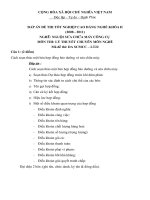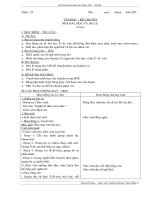PASSAGE 22
Bạn đang xem bản rút gọn của tài liệu. Xem và tải ngay bản đầy đủ của tài liệu tại đây (42.47 KB, 3 trang )
PASSAGE 22
The issue of equality for women in British society first attracted national attention in the early 20th
century, when the suffragettes won for women the right to vote. In the 1960s feminism became the subject
of intense debate when the women’s liberation movement encouraged women to reject their traditional
supporting role and to demand equal status and equal rights with men in areas such as employment and
pay.
Since then, the gender gap between the sexes has been reduced. The Equal Pay Act of 1970, for
instance, made it illegal for women to be paid less than men for doing the same work, and in 1975 the Sex
Discrimination Act aimed to prevent either sex having an unfair advantage when applying for jobs. In the
same year the Equal Opportunities Commission was set up to help people claim their rights to equal
treatment and to publish research and statistics to show where improvements in opportunities for women
need to be made. Women now have much better employment opportunities, though they still tend to get
less well-paid jobs than men, and very few are appointed to top jobs in industry.
In the US the movement that is often called the “first wave of feminism” began in the mid 1800s.
Susan B. Anthony worked for the right to vote, Margaret Sanger wanted to provide women with the
means of contraception so that they could decide whether or not to have children, and Elizabeth
Blackwell, who had to fight for the chance to become a doctor, wanted women to have greater
opportunities to study. Many feminists were interested in other social issues.
The second wave of feminism began in the 1960s. Women like Betty Friedan and Gloria Steinem
became associated with the fight to get equal rights and opportunities for women under the law. An
important issue was the Equal Rights Amendment (ERA), which was intended to change the Constitution.
Although the ERA was not passed, there was progress in other areas. It became illegal for employers,
schools, clubs, etc. to discriminate against women. But women still find it hard to advance beyond a
certain point in their careers, the so-called glass ceiling that prevents them from having high-level jobs.
Many women also face the problem of the second shift, i.e. the household chores.
In the 1980s, feminism became less popular in the US and there was less interest in solving the
remaining problems, such as the fact that most women still earn much less than men. Although there is
still discrimination, the principle that it should not exist is widely accepted.
Question 1. It can be inferred from paragraph 1 that in the 19th century, ______.
A. British women did not complete their traditional supporting role
B. most women did not wish to have equal status and equal rights
C. British women did not have the right to vote in political elections
D. suffragettes fought for the equal employment and equal pay
Question 2. The phrase “gender gap” in paragraph 2 refers to_____.
A. the visible space between men and women
B. the difference in status between men and women
C. the social distance between the two sexes
D. the social relationship between the two sexes
Question 3. Susan B. Anthony, Margaret Sanger, and Elizabeth Blackwell are mentioned as _____.
A. American women who were more successful than men
B. American women with exceptional abilities
C. pioneers in the fight for American women’s rights
D. American women who had greater opportunities
Page 1
Question 4. The Equal Rights Amendment (ERA)_____.
A. was not officially approved
B. changed the US Constitution
C. was brought into force in the 1960s
D. supported employers, schools and clubs
th
Question 5. In the late 20 century, some information about feminism in Britain was issued by _____.
A. the Equal Rights Amendment
B. the Equal Pay Act of 1970
C. the Equal Opportunities Commission
D. the Sex Discrimination Act
Question 6. Which of the following is NOT mentioned in the passage?
A. There is now no sex discrimination in Britain and in the US.
B. Many American women still face the problem of household chores.
C. An American woman once had to fight for the chance to become a doctor.
D. British women now have much better employment opportunities.
Question 7. Which of the following would be the best title for the passage?
A. Opportunities for Women Nowadays
B. Women and the Right to Vote
C. The Suffragettes in British Society
D. Feminism in Britain and the US
ĐÁP ÁN
1-C
2-B
6-A
7-D
3-C
4-A
5-C
LỜI GIẢI CHI TIẾT
Question 1:
Từ đoạn 1, có thể rút ra kết luận gì?
“the suffragettes won for women the right to vote” = những người phụ nữ đòi quyền bầu cử đã chiến
thắng trong việc dành quyền bầu cử cho phụ nữ => phụ nữ ở Anh khơng có quyền tham gia bầu cử trong
các cuộc bầu cử chính trị.
Question 2:
* gender gap: khoảng cách giới tính, sự phân biệt giới tính
Question 3:
“...the “first wave of feminism... Susan B. Anthony worked for the right to vote, Margaret Sanger wanted
to provide women with the means of contraception .... , and Elizabeth Blackwell ... wanted women to
have greater opportunities to study.” => Những người phụ nữ này là những người tiên phong đấu tranh
đòi quyền cho phụ nữ Mỹ.
Question 4:
“An important issue was the Equal Rights Amendment (ERA), which was intended to change the
Constitution. Although the ERA was not passed, there was progress in other areas” => ERA được dự định
là để thay đổi Quốc hội Hoa Kỳ. Mặc dù ERA không được phê duyệt nhưng lại có những tiến triển ở
những lĩnh vực khác.
=> ERA khơng được chính thức chấp thuận, phê duyệt
Question 5:
Page 2
“, and in 1975 the Sex Discrimination Act .... . In the same year the Equal Opportunities Commission was
set up to help people claim their rights to equal treatment and to publish research and statistics to show
where improvements in opportunities for women need to be made”
=> Equal Opportunities Commission đã cơng bố 1 số thơng tin về quyền bình đẳng của phụ nữ (nghiên
cứu và đưa các số liệu thống kê cho thấy những khu vực cần cải thiện về quyền lợi và cơ hội cho phụ nữ)
Question 6:
+ Đáp án B. nhiều phụ nữ Mỹ vẫn đối mặt với vấn đề làm việc nhà – CÓ : “Many women also face the
problem of the second shift, i.e. the household chores”
+ Đáp án C. Một người phụ nữ Mỹ từng đấu tranh để giành cơ hội trở thành bác sĩ. – CÓ : “Elizabeth
Blackwell, who had to fight for the chance to become a doctor”
+ Đáp án D. phụ nữ Mỹ hiện nay cơ hội việc làm tốt hơn rất nhiều. Có : “Women now have much better
employment opportunities”
=> Đáp án A. khơng có phân biệt về giới tính ở Anh và Mỹ => không được đề cập đến.
Question 7:
A. Cơ hội cho phụ nữ ngày nay
B. Nữ giới và quyền bầu cử
C. Những phụ nữ đòi quyền bầu cử cho nữ giới ở xã hội Anh
D. Phong trào đòi bình quyền cho phụ nữ ở Anh và Mỹ
=> chỉ có D là tóm lược đầy đủ nhất và đúng nhất cho nội dung bài đọc
Page 3









